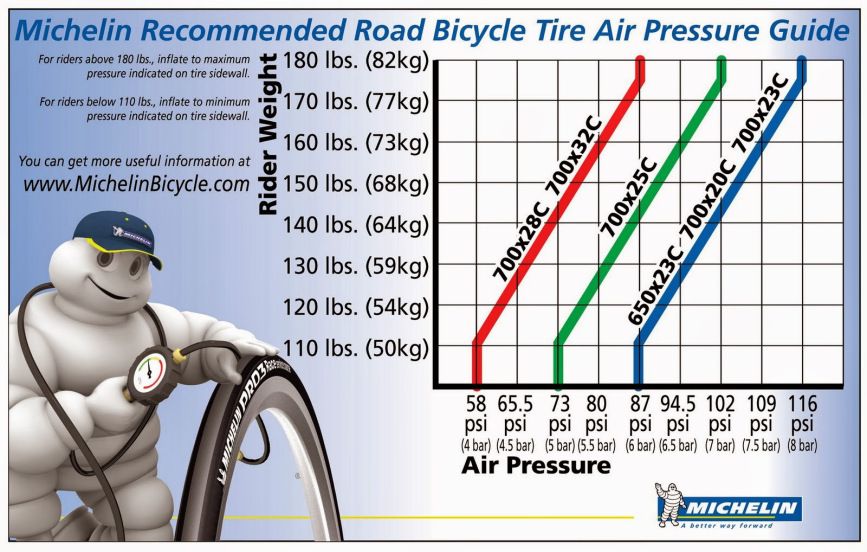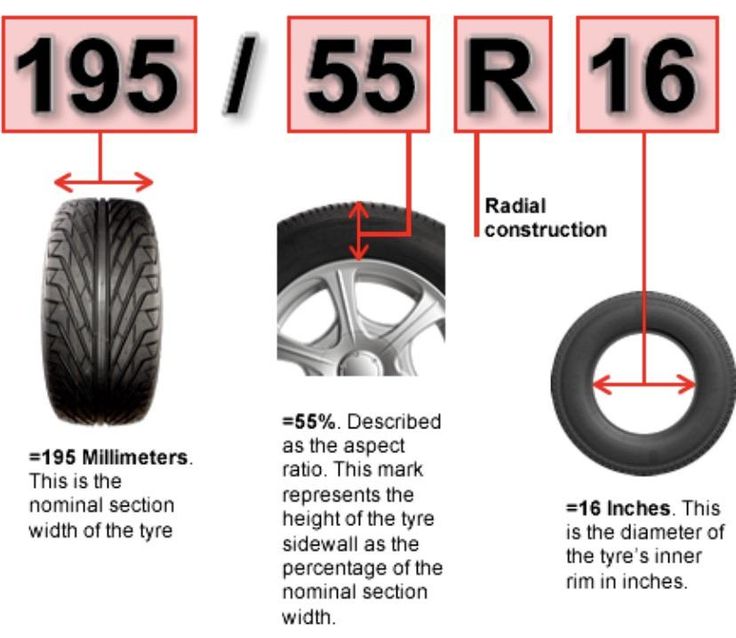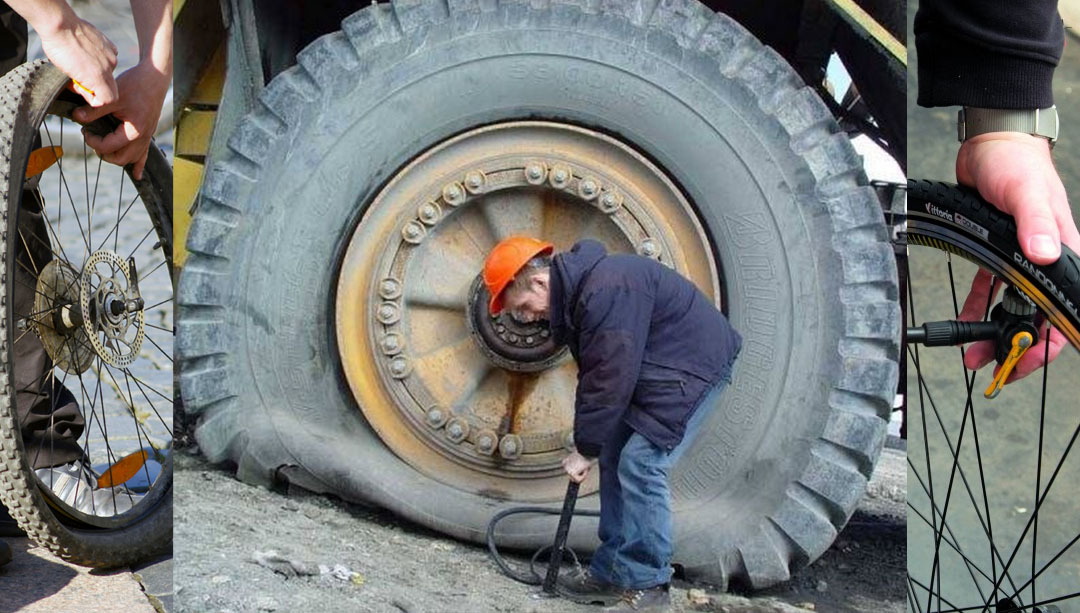Skip to content
All bike tires slowly leak air every day. Even if you’re an occasional rider, and you only take your bike down from the bike rack once a week, the tire pressure will still decrease. Before you ride, you should always check your tires’ PSI and, if needed, inflate them with a floor bike pump or a handheld pump.
On the sidewalls of your tires, you’ll see the manufacturer’s recommended pressure range for PSI (pounds per square inch). Different bike tires have different ranges, and narrow tires need more pressure than wide tires. The recommended PSI for different tires are:
Experienced cyclists can often estimate whether their tires need to be pumped by pinching the tire between their thumb and forefinger. The more accurate way of knowing when your tire should be pumped is by measuring its pressure with a pressure gauge; if the air pressure is measured below the recommended PSI, it’s time to pump.
First pump your bike tire to the middle of the range for the recommended PSI. You also need to take your body weight into account. Tires that bear a heavier rider need more PSI. Weather conditions and terrain also affect how a bike rides, so you’ll need to experiment with different PSIs to feel what’s most comfortable to you.
A Schrader valve is the type of valve you’ll find on car tires, older bike tires and mountain bikes. It consists of a metal pin in the center of a threaded valve, and a rubber cap that’s screwed onto the valve. Most bike pumps like those we reviewed have a dual head to accommodate both Schrader and Presta valves or a single head with an adapter.

A Presta valve is found on road bikes and some mountain bikes. It’s a slender valve with a nut at the top that is loosened and tightened before and after inflation. Almost all new bike pumps have a head with openings for both Schrader and Presta valves, or they have an adapter for switching from Schrader to Presta, like one of our top picks, the Topeak – Road Morph G.
If you’re out riding and your tires need air, you could give them a quick inflate with a CO2 injector, like the one we reviewed. But if you don’t have a CO2 injector in your bag, and you forgot your mini pump, then you can pull into a gas station and inflate your tires there.
If you don’t have a pressure gauge, ask the station attendant for one. Inflate your tires to optimal pressure in short bursts; a gas-station air pump has very high pressure, and you run the risk of popping your tire.
A gas-station air pump will only fit a Schrader valve. But if your tires have Presta valves and you don’t have a Presta valve adapter, there’s still a way to inflate them.
Share this Review
Gene Gerrard, Writer
Gene has written about a wide variety of topics for too many years to count. He's been a professional chef, cooking-appliance demonstrator, playwright, director, editor of accountancy and bank-rating books, Houdini expert and dog lover (still is). When he's not writing for Your Best Digs, he's performing as a magician at the Magic Castle in Hollywood.
He's been a professional chef, cooking-appliance demonstrator, playwright, director, editor of accountancy and bank-rating books, Houdini expert and dog lover (still is). When he's not writing for Your Best Digs, he's performing as a magician at the Magic Castle in Hollywood.
The easiest way to keep your bicycle running well and preventing flat tires is to keep your tires properly inflated. Properly inflated tires ride best, last longer, and resist punctures.
You should check your tires before every ride. Why? Your tires lose air over time, even overnight. How does this happen? The little molecules of air wiggle their way out between the molecules of rubber in the inner tubes and tires. The same thing happnes to your car tires, but it's not as critical because the amount of air lost is so small compared to the large volume of air in a car's tire. But with bicycle tires, a little bit of air makes a big difference. A bicycle tire can lose as much as 10% to 20% of its air in one day.
A bicycle tire can lose as much as 10% to 20% of its air in one day.
What happens when there's not enough air in your tires? Besides making your bike not as efficient as it should be, the biggest danger is what's called a "pinch flat." Suppose you run over a pothole, curb, rock, stick, or other sharp obstable. If the air pressure in your tires is too low, the inner tube gets pinched between the tire and the rim, and the edges of the rim cut two side-by-side holes into the inner tube, which is called a "snake bite."
For fatter rubber, such as what's on most off-road bikes, once a week is about right. But DON'T head to a service station and use the car-tire compressor! (They can explode a bike tire in seconds.) Do it with your "floor" (home) pump. Here's how.
Get a "floor" pump with built-in gauge for checking inflation.
Carry a portable pump for fixing flats on rides.
You need to know your tube's valve type to ensure that you purchase the correct tubes as replacements. And, so you know how to set up your pump, how to attach the pump to the valve and inflate the tire.
And, so you know how to set up your pump, how to attach the pump to the valve and inflate the tire.
To add or let air out of Presta valves, you must first unscrew the tip by turning it counterclockwise. To let air out, press down on the tip, which opens the valve. Also, before inflation, press down to make sure the valve is open.
For Schrader valves, to release air, press something into the valve to depress the valve core (the little pin inside the valve). To inflate, simply attach the pump and get to work.
Tips
 These provide a little protection and a "finished" look. But, many cyclists choose not to ride with them because it's easier to inflate tires when the caps are already removed.
These provide a little protection and a "finished" look. But, many cyclists choose not to ride with them because it's easier to inflate tires when the caps are already removed.There are many different types of pumps and the best way to guarantee using yours correctly is carefully reading the directions. Many modern pumps feature a head that fits both valve types. You simply use the hole that fits on the valve (skinny one for Presta and larger for Schrader).
Some pumps have convertible heads on which you must reassemble the parts when you want to pump up a different valve. If you have this type, set it up for the valves on your bicycle and keep the directions handy so you'll remember how to adapt it when necessary.
It's easy enough to attach the pump to the valve. Be sure to open a Presta valve first by unscrewing and briefly pressing on the tip. And, press the pump head on far enough (cover about one to two thirds of the valve).
If the pump head has a "lever lock," flip it to attach the head to the valve and start pumping (photo).
Tip: Don't pump too vigorously. Slow and steady gets the job done quickly and prevents pump damage (it's possible to harm the gauge by pumping too quickly).
How much tire pressure should you run? A practical approach is to use the manufacturer's recommended pressure, which you'll find printed on the tire sidewall (it's often on a small label but it might be molded into the casing, too, so look closely). This suggested inflation range is a good starting point. If it's a wide range, for example 40 to 60 psi, experiment to find which pressure works and feels best.
How the tires feel depends on rider weight, too. Check our chart for recommended pressures.
Tips

Hello everyone! In this article, we will tell you how to pump up a wheel on a bicycle. We'll give beginners tips on getting the right tire pressure, talk about different pumps, and cover all the challenges you might run into. Go!
To begin with, let's deal with tire pressure, since a lot depends on it, for example:
Bicycle manufacturers usually list the optimum bead pressure range, which can vary greatly depending on wheel width. For example, for fat bikes, the optimal pressure is from 0.5 to 2 atmospheres, for mountain bikes from 2 to 4 atmospheres. Well, for road models, suitable pressure ranges from 5 to 8 atmospheres.
Based on this, it can be concluded that the minimum pressure is used where it is necessary to ensure good grip on uneven surfaces. Well, the maximum pressure increases the roll on a flat surface. Therefore, we recommend that you inflate the wheels according to how you plan to ride. If you don't have a particular preference, inflate at a medium setting for good rolling and traction.
Therefore, we recommend that you inflate the wheels according to how you plan to ride. If you don't have a particular preference, inflate at a medium setting for good rolling and traction.
The weight of the cyclist should also be taken into account - if you weigh little, then it is better to choose a pressure closer to the minimum, and vice versa.
There are three standards of nipples used on modern bicycles. This is:
Schroeder is the best known type of nipple, which is also used in cars. Therefore, you will meet him on most bikes.
Presta is a thin nipple often referred to as a French nipple. These nipples are most commonly found on high-end bikes. As for the Dunlop standard nipples, they are very rare.
Some may think that each nipple requires a special pump. But this is not so - it is enough to purchase a regular car pump and an adapter for your type of nipple.
If you don't have a car pump, you can purchase a bicycle pump. Most of the models on sale are universal, and support all nipple standards at once. Bicycle pumps are:
Compact pumps pump the wheels for a long time, but they take up little space. They can be mounted directly on the frame, and always carry with you, which is very convenient.
Floor pumps are more comfortable to use as they blow in more air with one push. In addition, they are equipped with a pressure gauge that allows you to control tire pressure. These pumps are an indispensable tool for road bike owners.
That's all for today. Thank you for your attention, if this article was useful to you, please like us or share it with your friends. See you again.
Contents
Flat tires do not bode well for the cyclist. The situation must be resolved immediately, otherwise you will have to become a pedestrian for a while. What should be done? That's right, pump up the camera and calmly continue moving. Consider how to pump up a bicycle wheel with a pump, what subtleties are available when using an autocompressor, and whether it is possible to do without a pump.
The situation must be resolved immediately, otherwise you will have to become a pedestrian for a while. What should be done? That's right, pump up the camera and calmly continue moving. Consider how to pump up a bicycle wheel with a pump, what subtleties are available when using an autocompressor, and whether it is possible to do without a pump.
Tire pressure is the main parameter that is responsible for the speed of movement, grip and safety of the cyclist. The average minimum indicator for bicycles is 2 atmospheres. For driving on asphalt, the recommended value is within 3.5 atm., For primers - 2.6 - 2.8 atm.
It is easy and simple to determine the pressure inside the bicycle chamber using a pressure gauge - separate or built into the pump:

Another method: feel around the entire circumference of the tire with your fingers. If the rubber does not flex, then you can ride. It should be noted that this method will only give accurate results for thin slicks on road bikes and tires on city bikes.
Consequences of underinflated tyres:
On the contrary, an excess of air in the chambers threatens the following:
Maintaining the recommended pressure will eliminate all these shortcomings and allow you to get the most out of your trips and enjoy them. Below the values table depending on the weight of the cyclist:
| The mass of the cyclist, kg | atmospheres/PSI* |
| 50 | - 2. 59/35 - 38 59/35 - 38 |
| 77 | 2.72 – 2.9/40 – 42.6 |
| 90 | 3.6/53 |
| 105 | 3.9/57.5 |
| 115 | 4.1/60 |
| 118 | 3.2 - 3.4 1 atm = 14.696 Psi How to inflate a wheel with a hand pump In general, a bicycle pump is a necessary thing for every cyclist. With the help of this simple device, it will be possible to inflate the wheels on your own, and not roll your bike to a service or gas station. Hand pumps are divided into two types: simple and with a recording device (pressure gauge). It is recommended to purchase the second option, however, if a separate pressure gauge was lying around in the cabinet, you can buy a cheaper pump. Universal hand pump with dial gauge For ease of pumping with a conventional hand pump, you can immediately count the number of air inlets until the optimum pressure is reached and then pump exactly like this, even without additional use of a pressure gauge. How to correctly inflate the chambers:
Pressure tracking:
By the way, the latter will not be superfluous to do with a pressure gauge, since the pressure inside the pump can increase during pumping, but air does not enter the chamber (the valve is not completely closed) or exit through a hole in it. Common nipples for bicycles are automotive and Dunlop. For thin wheels, a Presta nipple with a valve is used. It requires cleanliness and accuracy in handling. Slim nipple Presta tubes are fitted to road bikes and some hybrids Fitted with a special low volume pump. A regular bike pump may not fit or you may need to use an adapter. Car pump - how to inflate tires with it Most bicycles have a "schrader" or car valve. The standard option allows you to inflate tires at gas stations and public bike pumps (of which there are only a few in our cities so far) directly. How to inflate simple wheels with a car pump:
How to fill Presta with a compressor at a gas station:
In this case, it is very important to know exactly how many atmospheres it is necessary to let air into the chambers. With increasing pressure, it can quickly burst. The last option left is Dunlop. It is identical in size to an automobile nipple, but in terms of design features it is similar to the French one (aka Presta). Methods for “pumpless” inflation of the inner tubesIs it possible to inflate bicycle inner tubes without a pump? It is unlikely to reach the recommended pressure, since a regular supply of pressurized air is required, but you can reach the minimum values. Let's consider several methods of pumping the chambers, which can be resorted to without using a pump: Vacuum cleaner. Many models are equipped with a blower mode that blows air out when switched to. A thin hose can be used to connect the wheel nipple. The result directly depends on the tightness of the connection between the hose and the nipple. Here you can use rubber pads, clamps and even rags. Bottle pump. You will need two plastic bottles. One of them will serve as a cylinder, the other as a rod. Cut off the bottom of the first bottle and connect its neck through a thin hose to the chamber outlet. |